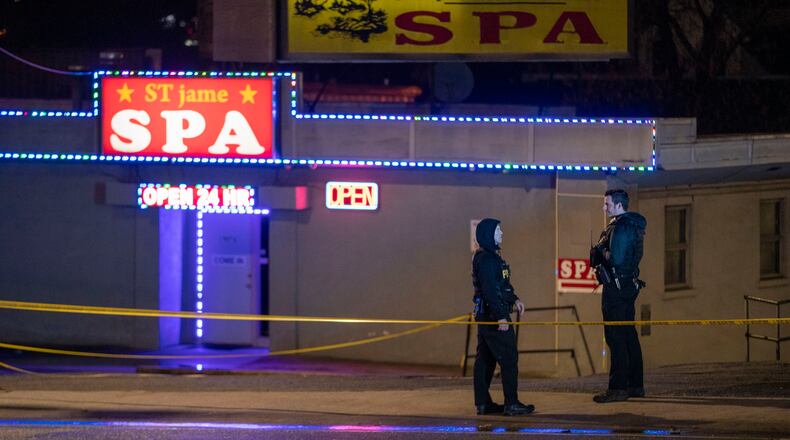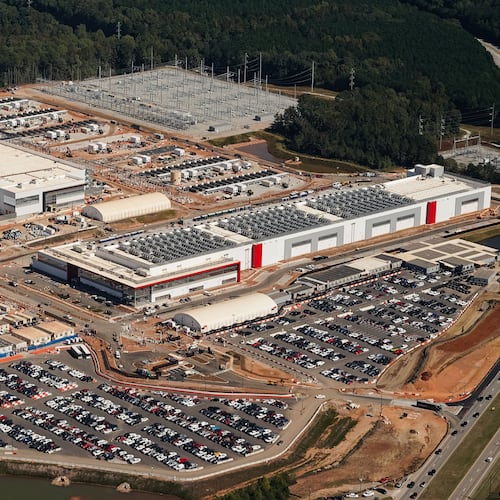There hadn’t been a mass shooting in America for a year when Robert Aaron Long embarked on his murderous spree on March 16 at three metro Atlanta spas, killing eight people.
Yeah, I know, the city of Atlanta’s murder rate went crazy last year, sending 157 people to the morgue, and this year has so far been worse. It’s the same in many other cities. But there hadn’t been an incident in which a deranged shooter hunted down human quarry in a public place since a gunman crashed his car into a Missouri convenience store in March 2020 and killed four people, one of them a cop, then killed himself.
Long’s crime set off a predictably intense cultural and political debate that has followed previous horrors ― discussions about violence, mental illness and widespread gun availability. Long bought his 9 mm pistol the day of the shooting spree.
But the fact that he targeted three spas and killed six Asian women who worked at those businesses, then claimed he suffered a sex addiction and wanted to wipe out his temptations, well, that brought forth a whole other set of arguments: misogyny, xenophobia, racism, sex and even the impact of strict religious influences.
Quickly, it became the ultimate case of an increasing wave of hate crimes against people of Asian descent. The coronavirus that causes COVID-19 first appeared in Wuhan, China, and the resulting yearlong pandemic has stirred anti-Asian animus ranging from verbal harassment to assault to a killing spree.
Mass shootings trigger an immediate search for what caused such evil. We are an impatient society that demands up-to-the-minute answers, news and opinions.
But there is a more pernicious side to that search for answers, writes conservative commentator David French: “Another part of this quest for an immediate explanation is toxic and destructive. Every single mass shooter (and, sadly, there are many of them) becomes an immediate weapon in the culture war. Did the shooter wear the red jersey or the blue jersey? Does he fit or defy an existing narrative?”
Some shootings have had an obvious theme to their slaughter. Or at least seem to.
In 2015, Dylann Roof, 21, entered a historic African American church in Charleston, South Carolina, and shot 10 people, killing nine. He admitted to targeting Black people out of hatred.
In 2016, Omar Mateen, 29, killed 49 people and wounded 53 in the Pulse, a gay nightclub in Orlando, Florida, before committing suicide. The motive seemed obvious. He had pledged allegiance to ISIS, the terrorist group that threw gays off buildings. However, in the subsequent criminal trial of his widow, evidence indicated he likely picked the nightclub at random while Googling and didn’t know it was a gay venue.
In 2017, Stephen Paddock, 64, fired more than 1,000 rounds on a crowd at a country music concert in Las Vegas from his 32nd-floor hotel suite, killing 58 people and wounding or injuring hundreds before killing himself. It was the worst mass shooting in U.S. history but the FBI was left clueless as to why he did it.
In 2018, Robert Gregory Bowers, 46, attacked a Pittsburgh synagogue, shooting and killing 11 people and wounding six. He had posted anti-Semitic comments online and was angry that a Jewish group helped immigrants.
In 2019, Patrick Wood Crusius, 21, shot and killed 23 people and wounded 23 at a Walmart in El Paso, Texas. He worried about a “Hispanic invasion” and told cops he targeted “Mexicans.”
In January 2016, I sat in an auditorium at an active shooter seminar held at Etowah High School in Cherokee County when fear of such shootings reached a fever pitch. (The latter four shootings I just mentioned had yet to happen.) The presenters from the Cherokee County Sheriff’s Department played a video of a slaughter at Virginia Tech, where a single gunman named Seung-Hui Cho killed 32 people in 2007. Most victims were shot lying down.
“So hiding and hoping is not an option,” Deputy Chief Joe Perkins told the crowd. “You are not helpless. You have to do something.”
The department encouraged a strategy akin to Homeland Security’s “Run, Hide, Fight” campaign.
At the time, Georgia’s future mass murderer was a junior in another high school in that same system. And Young’s Asian Massage, where one day four people would die, was just 2 miles away. I don’t know if the doomed people there were able to employ any lifesaving strategies in their horror-filled final seconds alive.
There have been scores upon scores of such scenes of death, terror and panic in American convenience stores, post offices, schools, nursing homes, churches and warehouses where the motives remain clouded, twisted or murky.
Common knowledge of mass shooters is that they are angry white guys who have fallen short despite their status in life and are left wanting to make others pay. The spa killings immediately became seen by many as a textbook case of “white supremacy.”
Days later, when a troubled young man killed 10 people in a Boulder, Colorado, grocery store, many quickly jumped on social media to say “Another white man killer!”
However, it was a Syrian-born man raised in the U.S. He is 21, the same age of three of the mass killers I’ve already mentioned.
I checked a database of mass shootings since 1982 that is operated by Mother Jones magazine, a decidedly left-leaning publication. It tracks every “mass shooting” since August 1982, when a mentally disturbed Miami teacher killed eight employees of a machine shop after disputing a $20 repair bill.
There have been 120 such incidents since, according to Mother Jones. You might have heard that mass shootings are common, and they are if you look at the research site Gun Violence Archive, which counts a mass shooting as any incident in which four people are shot, either killed or wounded. There were 25 such incidents in the U.S. in the most recent two weeks.
Mother Jones designates mass shootings as “indiscriminate rampages in public places resulting in four or more victims killed by the attacker.” Mother Jones excludes “shootings stemming from more conventionally motivated crimes such as armed robbery or gang violence.”
A check of the site knocks down the trope of white supremacist killers being the norm. (They surely exist ― as in Roof, Bowers and Crusius, who are noted above ― and who knows, possibly the recent spa killer.)
But according to Mother Jones, mass shooters look like … well, they look like the American population as a whole: 66 were white (or 54% of the killers), 21 were Black (or 17%), 10 were Hispanic (8%), eight were Asian (6.5%), five were “other” (4%), and three were Native Americans. The latest census says whites are 60% of the U.S. population, Blacks are 13.4%, Hispanics 18.5% and Asians 6%.
Every sector of the population owns this. This is obviously a huge, deeply complicated and emotional issue. And whether this is solved through better gun laws, mental health initiatives or more cultural empathy is yet to be seen.
But we can’t keep running, hiding and fighting.
About the Author
Keep Reading
The Latest
Featured




